
A polyptych is a painting which is divided into sections, or panels. Specifically, a diptych is a two-part work of art; a triptych is a three-part work; a tetraptych or quadriptych has four parts, whereas a polyptych describes any work of art formed of more than one constitutive part.

Pinturicchio, or Pintoricchio, also known as Benetto di Biagio or Sordicchio, was an Italian painter during the Renaissance. He acquired his nickname because of his small stature and he used it to sign some of his artworks that were created during the fifteenth and sixteenth centuries.

Carlo Crivelli was an Italian Renaissance painter of conservative Late Gothic decorative sensibility, who spent his early years in the Veneto, where he absorbed influences from the Vivarini, Squarcione, and Mantegna. He left the Veneto by 1458 and spent most of the remainder of his career in the March of Ancona, where he developed a distinctive personal style that contrasts with that of his Venetian contemporary Giovanni Bellini.

Ridolfo di Domenico Bigordi, better known as Ridolfo Ghirlandaio was an Italian Renaissance painter active mainly in Florence. He was the son of Domenico Ghirlandaio.

Saint Sebastian is a painting, once part of a triptych by the Italian Renaissance artist Antonello da Messina, completed in 1477–1479. It is housed in the Gemäldegalerie Alte Meister, Dresden, Germany.

VittorioCrivelli was an Italian painter and brother of Carlo Crivelli. His works are similar in style to his brother's, but less accomplished.
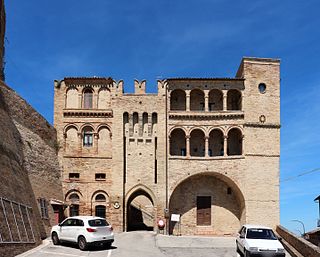
Massa Fermana is a comune (municipality) in the Province of Fermo in the Italian region Marche, located about 50 kilometres (31 mi) south of Ancona and about 35 kilometres (22 mi) northwest of Ascoli Piceno.
The decade of the 1430s in art involved some significant events.
Pietro Alemanno was an Italian-Austrian painter of the Renaissance period.

The Recanati Polyptych is an oil-on-panel painting by the Italian Renaissance painter Lorenzo Lotto, executed in 1506–1508 and housed in the Civic Museum of Villa Colloredo Mels, Recanati, Italy. The work is dated and signed Laurent[ius] Lotus MDVIII.

The Annunciation has been one of the most frequent subjects of Christian art. Depictions of the Annunciation go back to early Christianity, with the Priscilla catacomb in Rome including the oldest known fresco of the Annunciation, dating to the 4th century.

The Annunciation, with Saint Emidius is an altarpiece by Italian artist Carlo Crivelli showing an artistic adaptation of the Annunciation. It was painted for the Church of SS. Annunziata in the Italian town of Ascoli Piceno, in the region of Marche, to celebrate the self-government granted to the town in 1482 by Pope Sixtus IV. The painting was removed to the Pinacoteca di Brera in Milan in 1811, but passed to Auguste-Louis de Sivry in 1820, and had reached England by the mid-19th century. It has been housed in the National Gallery in London since it was donated by Henry Labouchere, 1st Baron Taunton in 1864.

Anatolian animal carpets represent a special type of pile-woven carpet, woven in the geographical region of Anatolia during the Seljuq and early Ottoman period, corresponding to the 14th–16th century. Very few animal-style carpets still exist today, and most of them are in a fragmentary state. Animal carpets were frequently depicted by Western European painters of the 14th–16th century. By comparison of the few surviving carpets with their painted counterparts, these paintings helped to establish a timeline of their production, and support our knowledge about the early Turkish carpet.
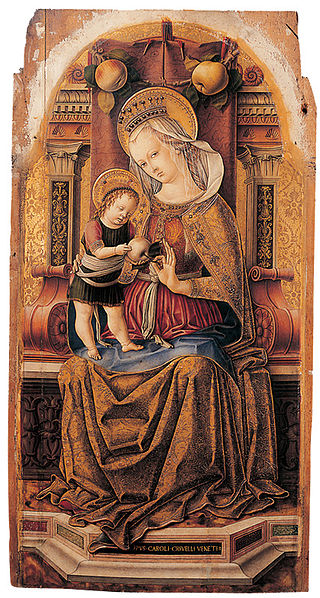
The St Peter Martyr Altarpiece or Minor San Domenico Altarpiece is a altarpiece in tempera and gold on panel by the Italian Renaissance painter Carlo Crivelli, executed c. 1476. Its central panel of the Madonna and Child, signed "OPVS CAROLI CRIVELLI VENETI", is now in the Museum of Fine Arts in Budapest. The altarpiece's other panels were seen in Rome by Luigi Lanzi in 1789 before being moved to Florence with the Rinuccini family. In 1868 it moved from the Demidov collection to the National Gallery in London, where they still hang.

The 1476 Altarpiece or San Domenico Altarpiece is a 1476 tempera and gold on panel altarpiece by Carlo Crivelli. Its central panel of the Pietà is now in the Metropolitan Museum of Art in New York, whilst the other nine are now in the National Gallery, London.
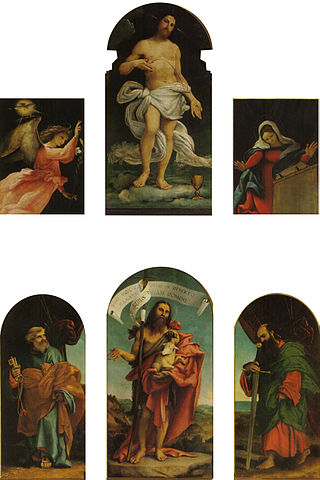
The Ponteranica Altarpiece is a six-panel oil painting series produced by Lorenzo Lotto in 1522, commissioned by the Scuola del Corpo di Cristo for the parish church of San Vincenzo e Sant'Alessandro in Ponteranica, where it still remains. Its upper register shows the risen Christ flanked by an Annunciation scene, whilst below is John the Baptist flanked by saints Peter and Paul.
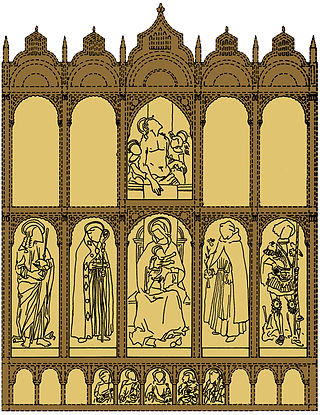
The 1472 Altarpiece was a tempera and oil on panel altarpiece by the Italian Renaissance painter Carlo Crivelli, dated 1472 on the central panel. Also known as the Fesch Altarpiece or the Eckinson Altarpiece, it is now divided up between a number of galleries in the United States and Europe.

Adoration of the Shepherds is a c. 1480 tempera and gold on panel painting by the Italian painter Carlo Crivelli. It is now in the Museum of Fine Arts in Strasbourg, for which it was acquired in Florence by Wilhelm von Bode. Its inventory number is 171. Art historians are uncertain about the dating of the painting, and propositions have ranged from 1470 to 1491.

The Porto San Giorgio Altarpiece or Porto San Giorgio Polytpych was a 1470 multi-panel tempera and gold on panel altarpiece by the Italian Renaissance painter Carlo Crivelli. Stylistically similar to Crivelli's Massa Fermana Altarpiece, the work was a fundamental step in his evolution away from the Paduan Renaissance towards a more delicate and realist style.
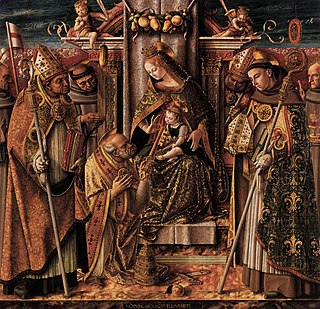
The San Pietro di Muralto Altarpiece or San Pietro degli Osservanti Altarpiece is a 1488–1489 tempera and gold on panel altarpiece by Carlo Crivelli and his studio, named after the Dominican church in Camerino in which it originally hung, and now divided between a number of American and European museums.

















